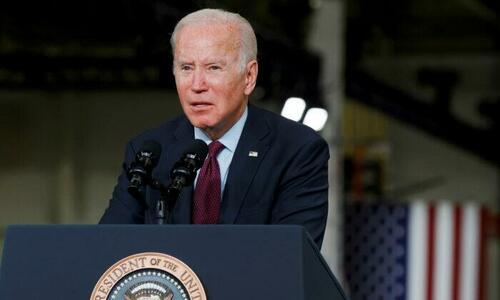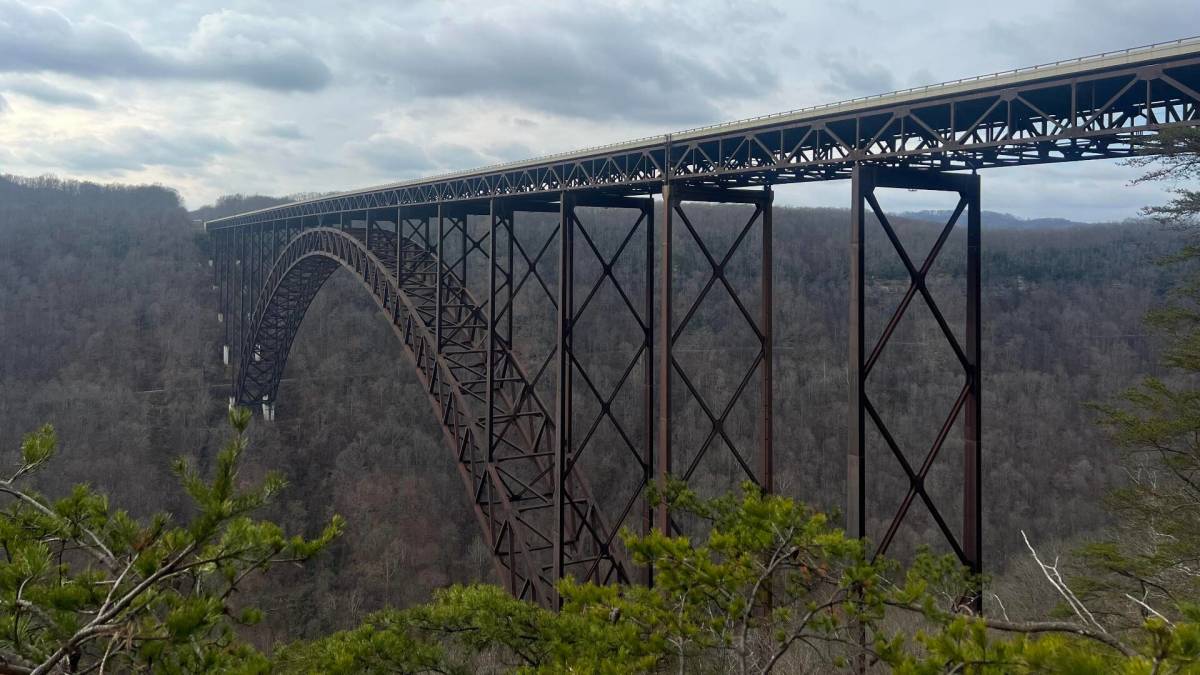Government
Here’s Why “America Is Broken” And People Are Worried
Here’s Why "America Is Broken" And People Are Worried
The NY Times on Monday published an opinion piece by UPenn senior lecturer and Open…

The NY Times on Monday published an opinion piece by UPenn senior lecturer and Open Society Project senior fellow (!) Damon Linker titled "Why Is Biden Struggling? Because America Is Broken."
And while it's more or less a recap of what ZeroHedge readers have known for years, the essay provides a sobering dose of reality for the "You should really watch Rachel Maddow" types.
Seven months away from a rematch election pitting President Biden against former President Donald Trump, the incumbent is struggling. Mr. Biden suffers from persistently low approval ratings, he barely manages to tie Mr. Trump in national head-to-head polls and he lags behind the former president in most of the swing states where the election will be decided (despite some recent modestly encouraging movement in his direction).
The question is why. -NY Times
Biden's defenders, and the administration itself, has chalked the president's unpopularity up to "a failure of communication," however Linker instead suggests "It's usually wiser to listen to what voters are saying" (beyond the obvious concerns about the president's age).
'Too Numerous to List'
Citing a January 2021 essay in Tablet titled "Everything Is Broken," and a follow-up essay by the same author, Alana Newhsouse, who wrote that "whole parts of American society were breaking down before our eyes," Linker encapsulates why Americans are so pissed (h/t Dean Baker):
The examples are almost too numerous to list: a disastrous war in Iraq; a ruinous financial crisis followed by a decade of anemic growth when most of the new wealth went to those who were already well off; a shambolic response to the deadliest pandemic in a century; a humiliating withdrawal from Afghanistan; rising prices and interest rates; skyrocketing levels of public and private debt; surging rates of homelessness and the spread of tent encampments in American cities; undocumented migrants streaming over the southern border; spiking rates of gun violence, mental illness, depression, addiction, suicide, chronic illness and obesity, coupled with a decline in life expectancy.
That’s an awful lot of failure over the past 20-odd years. Yet for the most part, the people who run our institutions have done very little to acknowledge or take responsibility for any of it, let alone undertake reforms that aim to fix what’s broken. -NYT
Linker then writes that the above is why "angry anti-establishment populism has become so prominent in our politics over the past decade," which both Donald Trump and Bernie Sanders have capitalized on.
And Biden, a career politician, has been part of the problem (and therefore implicated in these abject societal failures), and is "badly out of step with the national mood, speaking a language very far removed from the talk of a broken country that suffuses Mr. Trump’s meandering and often unhinged remarks on the subject." (gotta get that shot in!)
That leaves Mr. Biden as the lone institutionalist defender of the status quo surrounded by a small army of brokenists looking for support from an electorate primed to respond to their more downcast message.
Linker suggests that in order to recover, Biden 'stop being so upbeat' - about the economy in particular, and stop making the election about how awful Trump is. Biden "should admit Washington has gotten a lot of things wrong over the past two decades and sound unhappy about and humbled by it."
Further, Biden "could make the argument that all governments make mistakes because they are run by fallible human beings — but also point out that elected representatives in a democracy should be up front about error and resolve to learn from mistakes so that they avoid them in the future."
"Just acknowledging how much in America is broken could generate a lot of good will from otherwise skeptical and dismissive voters," Linker suggests.
Let's see how that goes.
International
United Airlines delays route passengers had looked forward to
The airline has poured a lot of resources into marketing its new Newark-Faro flight.

While the most common way for American travelers to get to Portugal had formerly been with a flight to Lisbon (or a transfer in a larger European hub), the country’s exploding popularity has pushed airlines to launch more routes not just to the capital but also to smaller cities that are common destinations for tourists.
For the summer of 2024, Delta Air Lines (DAL) resumed a Boston-Lisbon route that was lost to the pandemic while United Airlines (UAL) announced a new flight between Newark International Airport (EWR) and Faro in the country’s coastal Algarve region.
Related: This is why you won't be able to get a low-cost flight to Tulum anytime soon
The latter flight, which was initially scheduled to start running on May 24 on a Boeing 757-200 (BA) , is now put off indefinitely as both Boeing and United face investigations over several high-profile incidents such as when smoke filled the cabin on a plane taking off from Los Angeles and a tire falling off at San Francisco International Airport (SFO).
Shutterstock
There is a big reason that a glitzy new route was canceled
While no injuries were caused, the airline is holding off on the route that it would want to launch to great fanfare to focus on both the investigation and rebuilding its PR image.
More Travel:
- A new travel term is taking over the internet (and reaching airlines and hotels)
- The 10 best airline stocks to buy now
- Airlines see a new kind of traveler at the front of the plane
“It's unlike United to cancel such a splashy new route with such short notice, especially considering how the carrier made a big marketing push around the new route when it was originally announced in October,” writes Zach Griff of The Points Guy. “Turns out, the reason for United's close-in cancellation is due to the ongoing Federal Aviation Administration (FAA) audit that commenced just a few days ago due to recent safety events involving the airline, as confirmed by a carrier spokesperson.”
The same spokesperson said that it still plans to launch the Newark-Faro flight by the summer of 2025 but did not give any more concrete details about the schedule. It is also delaying a “fifth freedom” route that goes from the U.S. to Tokyo and later on to Cebu in the Philippines.
Both destinations have been seeing growing interest from American tourists and the airline tried to tap into a market that was formerly filled only by smaller local airlines that tourists from far away would catch after flying into a metropolis.
There’s been a wrinkle in United’s plan to tap into hot new tourist destinations
"We have consistently been ahead of the curve in finding hidden gem destinations for our customers to explore and remain committed to providing the most unique slate of travel options for their adventures abroad," United's Senior Vice President of Global Network Planning Patrick Quayle said in a statement at the time.
Now, the airline is delaying such routes that it launched both to market itself as an airline that flies to such popular destinations and to slowly build out demand in order to focus on the investigation and bad publicity that came as a result of the recent safety incidents.
“This schedule change is a consequence of that,” United said in a statement while adding that those who had already booked flights to Faro or Cebu on their site will receive communication from the airline and a “full refund” of what they paid.
stocks pandemic europeanInternational
These National Parks are the most expensive to visit
A new report looks at the cost of entry fees at the country’s national parks.

While the 63 national parks spread across the U.S. are an inextricable part of American culture, visiting all of them is by no means a cheap endeavor.
Many are not easy to access without a car and, along with the usual travel and accommodation costs of going to so many states and territories, the parks themselves also charge visitors fees at different points in their visit. Sometimes this is exclusively for “extras” such a spot on a camping site but, increasingly, parks have been either raising or introducing entry and parking fees amid overcrowding.
Related: I visited two of the country's most underrated National Parks — here's what it was like
The most expensive national park in the U.S. is, as travel journalist Stephen Hanson recently identified in a fare comparison, the Gates Of The Arctic National Park & Preserve in Northern Alaska.
Veronika Bondarenko
This is the most remote (and often most expensive) national park to visit
Often dubbed the “most remote national park in the U.S.,” the Gates of the Arctic has no entry fee but is incredibly costly to get to due to its location in the far north of the Arctic. Without direct road access, the only way to get there is to fly from Anchorage to the nearest small settlement such as Kotzebue or Anaktuvuk Pass by charter plane. The Arctic terrain also means visitors often need to hire guides, pay inflated prices for the limited accommodation and bring special gear.
More Travel:
- A new travel term is taking over the internet (and reaching airlines and hotels)
- The 10 best airline stocks to buy now
- Airlines see a new kind of traveler at the front of the plane
“While many beautiful national parks in the US are well worth a trip despite their remote setting, Gates of the Arctic National Park & Preserve requires a particularly dedicated resolve from any traveler who wants to visit,” Hanson writes. “Though prices can vary depending on the length of the trip and the destination, passengers can expect to pay anywhere from a few hundred to a few thousand dollars for a ticket.”
Channel Islands National Park off the coast of Southern California is the country’s second-most expensive in the U.S. for a similar reason. The five Channel Islands sit in the Pacific Ocean and can only be accessed by ferry from Ventura Harbor. Depending on the time of day and year, the three-hour ferry ranges in price from $60 to $120 (the park itself, once you get there, has no entry fee.)
These national parks are also very expensive (here is why)
Parks that are easily accessible by car but have high entry fees due to overcrowding include Yosemite in California’s Sierra Nevada Mountains and Glacier National Park on the border between Montana and Canada’s British Columbia.
Both parks charge each vehicle coming in a $35 entry fee on top of additional additional fees for staying there overnight. In 2021, Yosemite raised the camping fee from $6 to $10 per person to keep up with the cost of running the park amid growing numbers of people who started visiting as part of their local travels during the pandemic.
“Visitors should be prepared to spend more money on gas and set aside an entire day for travel when heading out to the park,” Hanson writes of Glacier National Park. “Upon arriving, visitors to Glacier will have to pay a $35 entry fee.”
SEE THE FULL LIST OF MOST EXPENSIVE NATIONAL PARKS HERE.
stocks pandemic spread canadaInternational
Tackling social isolation could be more effective than healthy eating for obesity
A recent study showed encouraging people with obesity to interact with others more can keep them alive for longer.

People with obesity are commonly urged to lose weight by eating more healthily, cutting down on calorie intake and exercising more – but that advice overlooks a crucial problem.
It overstates individual agency – putting the person at fault because of poor lifestyle choices – and doesn’t take into account all the factors contributing to the obesity crisis. For instance, research has found that there are significant social determinants of obesity, such as poverty, stigma and loneliness.
A recent study of people in the UK has suggested that one way to keep obese people alive for longer is to encourage them to interact more with other people.
Why exactly might this be?
The study came to its conclusion using something called hazard ratios, a measure of how often a particular event happens in one group compared to how often it happens in another group, over time. It found that people who’re less socially isolated have a reduced hazard ratio of death from any cause (known as all-cause mortality). This means that people who’re more socially connected are less likely to die prematurely from any cause.
This is even more significant in people with obesity. Isolation has a bigger affect on the risk of death in people with obesity than those at a healthy weight. Those with obesity showed a four times greater reduction in mortality risk than people without obesity when their levels of social isolation fell.
We also know obesity leads to a higher risk of social isolation, which in turn has mental and physical health implications. So it’s not surprising that reducing social isolation amongst among people who are obese would reduce the risk of mortality.
However, the degree of change is perhaps unexpected. It means that tackling social isolation could make a bigger difference to those with obesity than other contributing factors. In fact, the study found a reduction in social isolation more associated with decreased risk of death than any other factor, including a healthy diet, physical activity, alcohol consumption, depression and anxiety.
Relationship between social isolation and obesity
Obesity is a medical condition where people have excessive body fat, as measured by their body mass index. Growing rates of obesity means some studies predict around 20% of the global adult population will be obese by 2030.
And the problem is worse in high income countries. Around 25% of adults in the UK are already considered obese, and the rate in the US could become as high as 45% by 2035.
This rise is intertwined with growing levels of social isolation and loneliness. Both increased during the COVID pandemic and and both are linked with a greater risk of mortality, just like obesity.
There is a two-way relationship between obesity and social isolation. In an attempt to escape feelings of isolation, people may consume more food and drink than usual, or eat more unhealthy foods such as chocolate, cake, biscuits – so called comfort foods.
Being isolated and feeling lonely can also lead to a reduction in exercise. Both excessive eating of unhealthy food and a lack of exercise will inevitably lead to weight gain.
On the other hand, obesity can lead to social isolation and loneliness, as people experience stigmatisation, rejection, discrimination, bullying, self-blame and reduced self-esteem. It can also engender a loss of trust in others, and a perception that social situations pose a threat, so are best avoided.
We also know obesity is associated with poorer mental health, especially in women.
Unsurprisingly then, obese people are more likely to isolate themselves, avoid spending time in public places and interacting with others. This can include an avoidance of health care settings, preventing those struggling with weight gain from getting the necessary support.
The most recent study demonstrates the significant damage that social isolation can have on those with obesity. The findings should not be interpreted as a signal that the sole answer to health risks of obesity is making social connections. However, the study should prompt a rethink of attitudes and approaches to obesity that focus exclusively on the individual’s diet and exercise. Research has shown that the traditional “eat less, move more” advice is simplistic and outdated.
Healthy eating and exercise should not be prioritised in obesity treatment at the expense of all other factors. To reduce the mortality risk of obesity, social isolation must be taken into account alongside healthy eating and physical activities. Tackling obesity, then, should include group activities and opportunities for regular social interaction in safe welcoming environments.
Andrea Wigfield does not work for, consult, own shares in or receive funding from any company or organisation that would benefit from this article, and has disclosed no relevant affiliations beyond their academic appointment.
depression pandemic treatment mortality uk-

 International2 weeks ago
International2 weeks agoParexel CEO to retire; CAR-T maker AffyImmune promotes business leader to chief executive
-

 Spread & Containment4 weeks ago
Spread & Containment4 weeks agoIFM’s Hat Trick and Reflections On Option-To-Buy M&A
-

 International1 month ago
International1 month agoEyePoint poaches medical chief from Apellis; Sandoz CFO, longtime BioNTech exec to retire
-

 International1 month ago
International1 month agoWalmart launches clever answer to Target’s new membership program
-

 Uncategorized7 days ago
Uncategorized7 days agoVaccinated People Show Long COVID-Like Symptoms With Detectable Spike Proteins: Preprint Study
-

 Uncategorized3 days ago
Uncategorized3 days agoCan language models read the genome? This one decoded mRNA to make better vaccines.
-

 Uncategorized17 hours ago
Uncategorized17 hours agoWhat’s So Great About The Great Reset, Great Taking, Great Replacement, Great Deflation, & Next Great Depression?
-

 Government2 days ago
Government2 days agoClimate-Con & The Media-Censorship Complex – Part 1



















